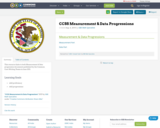
This resource links to both Measurement & Data progression documents published by the Common Core Writing Teams in June 2011.
- Material Type:
- Assessment
- Homework/Assignment
- Teaching/Learning Strategy
- Date Added:
- 05/09/2013

This resource links to both Measurement & Data progression documents published by the Common Core Writing Teams in June 2011.
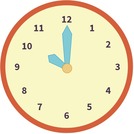
This is an ESL lesson meant for WIDA Level 1 or "Entering" ELLs that focuses on learning how to read and talk about an analog clock. It is built upon the principles of Brain-Based learning and teaching. Therefore, the lesson focuses on realia, sensory stimulus, and multimodality.
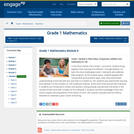
In this final module of the Grade 1 curriculum, students bring together their learning from Module 1 through Module 5 to learn the most challenging Grade 1 standards and celebrate their progress. As the module opens, students grapple with comparative word problem types. Next, they extend their understanding of and skill with tens and ones to numbers to 100. Students also extend their learning from Module 4 to the numbers to 100 to add and subtract. At the start of the second half of Module 6, students are introduced to nickels and quarters, having already used pennies and dimes in the context of their work with numbers to 40 in Module 4. Students use their knowledge of tens and ones to explore decompositions of the values of coins. The module concludes with fun fluency festivities to celebrate a year's worth of learning.
Find the rest of the EngageNY Mathematics resources at https://archive.org/details/engageny-mathematics.
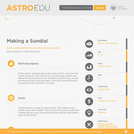
In this activity, students discuss the notion of time and how time can be measured. They learn that a long time ago, people used different tools to measure time. Students build and use a sundial and discover that a long time ago, it was much more difficult to accurately tell the time than it is today.
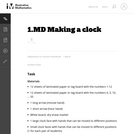
This task is to introduce students to the concept of reading an analog clock.

This resource was created by the Washington Office of Superintendent of Public Instruction.

(Nota: Esta es una traducción de un recurso educativo abierto creado por el Departamento de Educación del Estado de Nueva York (NYSED) como parte del proyecto "EngageNY" en 2013. Aunque el recurso real fue traducido por personas, la siguiente descripción se tradujo del inglés original usando Google Translate para ayudar a los usuarios potenciales a decidir si se adapta a sus necesidades y puede contener errores gramaticales o lingüísticos. La descripción original en inglés también se proporciona a continuación.)
En el módulo 5, los estudiantes consideran parte de las relaciones completas a través de una lente geométrica. El módulo se abre con estudiantes que identifican las partes definidas, o atributos, de formas dos y tridimensionales, basándose en sus experiencias de jardín de infantes de clasificación, análisis, comparación y creación de varias formas y objetos de dos y tridimensionales. Los estudiantes combinan formas para crear un nuevo todo: una forma compuesta. También relacionan las figuras geométricas con partes iguales y nombran las partes como mitades y cuartos. El módulo se cierra con estudiantes que aplican su comprensión de las mitades para decir tiempo a la hora y media hora.
Encuentre el resto de los recursos matemáticos de Engageny en https://archive.org/details/engageny-mathematics.
English Description:
In Module 5, students consider partwhole relationships through a geometric lens. The module opens with students identifying the defining parts, or attributes, of two- and three-dimensional shapes, building on their kindergarten experiences of sorting, analyzing, comparing, and creating various two- and three-dimensional shapes and objects. Students combine shapes to create a new whole: a composite shape. They also relate geometric figures to equal parts and name the parts as halves and fourths. The module closes with students applying their understanding of halves to tell time to the hour and half hour.
Find the rest of the EngageNY Mathematics resources at https://archive.org/details/engageny-mathematics.

(Nota: Esta es una traducción de un recurso educativo abierto creado por el Departamento de Educación del Estado de Nueva York (NYSED) como parte del proyecto "EngageNY" en 2013. Aunque el recurso real fue traducido por personas, la siguiente descripción se tradujo del inglés original usando Google Translate para ayudar a los usuarios potenciales a decidir si se adapta a sus necesidades y puede contener errores gramaticales o lingüísticos. La descripción original en inglés también se proporciona a continuación.)
En este módulo final del plan de estudios de Grado 1, los estudiantes reúnen su aprendizaje del Módulo 1 al Módulo 5 para aprender los estándares de Grado 1 más desafiantes y celebrar su progreso. A medida que se abre el módulo, los estudiantes lidian con tipos de problemas de palabras comparativas. A continuación, extienden su comprensión y habilidad con decenas y números a 100. Los estudiantes también extienden su aprendizaje del módulo 4 a los números a 100 para sumar y restar. Al comienzo de la segunda mitad del módulo 6, los estudiantes se introducen en los monedas de montaña y cuartos, ya que ya han usado centavos y diez centavos en el contexto de su trabajo con los números a 40 en el módulo 4. Los estudiantes usan su conocimiento de decenas y otras para explorar las descomposiciones de los valores de las monedas. El módulo concluye con festividades divertidas de fluidez para celebrar un año de aprendizaje.
Encuentre el resto de los recursos matemáticos de Engageny en https://archive.org/details/engageny-mathematics.
English Description:
In this final module of the Grade 1 curriculum, students bring together their learning from Module 1 through Module 5 to learn the most challenging Grade 1 standards and celebrate their progress. As the module opens, students grapple with comparative word problem types. Next, they extend their understanding of and skill with tens and ones to numbers to 100. Students also extend their learning from Module 4 to the numbers to 100 to add and subtract. At the start of the second half of Module 6, students are introduced to nickels and quarters, having already used pennies and dimes in the context of their work with numbers to 40 in Module 4. Students use their knowledge of tens and ones to explore decompositions of the values of coins. The module concludes with fun fluency festivities to celebrate a year's worth of learning.
Find the rest of the EngageNY Mathematics resources at https://archive.org/details/engageny-mathematics.
![OREGON MATH STANDARDS (2021): [1.GM]](https://img.oercommons.org/160x134/oercommons/media/courseware/lesson/image/13138_ODE_Math_Logo_2018-H_color_BvjqVNy.png)
The intent of clarifying statements is to provide additional guidance for educators to communicate the intent of the standard to support the future development of curricular resources and assessments aligned to the 2021 math standards. Clarifying statements can be in the form of succinct sentences or paragraphs that attend to one of four types of clarifications: (1) Student Experiences; (2) Examples; (3) Boundaries; and (4) Connection to Math Practices.